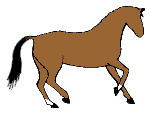Virtual Lessons - The Canter
(Reproduced with permission from the copyright owners www.newrider.com)
The canter is a pace of three time, like a waltz, and the back of the horse should come up under the rider, so that each stride feels like a little jump.

Very often, riding school horses are not schooled so that their hind legs act to push them forward from behind- instead, the horse just pulls himself along with his front legs, and his back flips up and down, making it difficult for the rider to sit to. Again, the more the rider bounces, the more the horse will stiffen up his back. It is very uncomfortable for him, and is often the primary cause of why so many horses are reluctant to canter, and why beginner riders find it so difficult to maintain the canter. Horses that are sensitive and more forward going by nature, tend to react by running off and speeding up.
It is the rider's lower back that must absorb the canter movement, not the upper body by 'rowing' the shoulders back and forth, as if rowing a boat. Not only does the latter look ugly, the seat bones are pushed down concavely against the horse's back, which is trying to come up convexly under the rider, if the canter is not to be flat and lifeless. �Rowing� with the shoulders also makes the seat heavy, and 'squashes' the canter, making it very much more difficult for the horse to lift and round his back under the rider. I have another simulator at home which is purely rider powered, i.e. it acts on springs. If the rider scoops the backside into the saddle, 'polish the saddle' as you hear some instructors advocate, the machine reacts by 'bottoming' on it's springs and nearly bucking the rider off! The sobering thought is that if it does this to a machine, how much worse must it feel to the horse?
So how do we absorb the movement of the canter? Again, sitting on the stool, place your hands on your hipbones, so that you can feel, and flex your back in, and straighten the spine again, just as you did at the beginning of the trot exercise, but now moving the hipbones forward and back to upright together, not separately, (as in trot), at least at this stage in your riding career, and in the smooth, (call out loud again) one, two three, one, two, three, time of the canter. Allowing the lower back to absorb the movement in this way does not prevent the horse from raising his back. The seat bones acting as a pivot, merely mirror the rise and fall of the horse's back, allowing the canter to rise up under the rider's seat, and not restricting the back of the horse. The rider also appears to remain very still in the saddle, which is so much more pleasing to the eye, than all of this obtrusive upper body movement that is so often seen in canter, and a darn sight more comfortable for both parties!
 Uncle Nev's Trail Rides
Uncle Nev's Trail Rides

